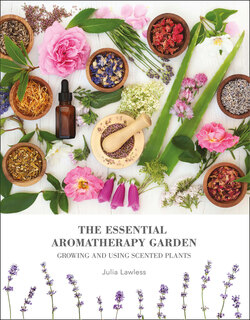Читать книгу The Essential Aromatherapy Garden - Julia Lawless - Страница 18
ОглавлениеTHE AROMATHERAPY HERB GARDEN
In the Middle Ages, scented herbs such as rosemary or lavender were widely used for alleviating damp musty smells and offsetting the effects of poor sanitation, as well as being employed in the sickroom for their antiseptic and disinfectant properties. Herbs such as the cinnamon-scented sweet rush (Acorus calamus) or sweet woodruff (Galium odoratum) were used for strewing on floors. Meadowsweet (Filipendula ulmaria) was a favourite herb of Elizabeth I, who had it laid on the floors of her palaces. Others such as hyssop, lavender, sage, chamomile and germander, which release their fragrance when trodden on, were very popular with the gentry and in churches. Bay leaves were also used to disinfect the atmosphere in churches, and chapels strewn with fresh bay leaves can still be found in Italy and other parts of the Mediterranean. Professional perfumers were employed to fumigate rooms in Tudor England, while at the time of James II there was even a ‘Strewer of Herbs in Ordinary to his Majesty’. In more modest cottages, sweet-scented apple wood was burned along with ploughman’s spikenard or nard (Inula conyzae) – a species of elecampane.
Aromatic flowers and herbal sprigs were also bound into small posies called ‘tussie mussies’ to ward off sickness or infection and to act as amulets whilst travelling. Herbs such as St John’s wort, rosemary, wormwood, mugwort, rue and bay were all thought to have potent protective qualities, and were often planted by doors or hung by windows to ward off bad spirits. Bundles of dried herbs or aromatic powders were also used extensively to scent household items such as bedlinen, clothes or furniture, as well as helping to keep insects and moths at bay. Pot pourri was commonly made using the petals from an enormous range of flowers including roses, marigolds, lavender, iris (orris) and lemon verbena. Perfumes, flower waters and other cosmetic lotions concocted from specially cultivated plants were also popular, the recipes for which would be passed on from generation to generation (see Chapter 5).
Lavender (Lavandula augustifolia), used in the Middle Ages to alleviate bad smells.
Marek Walica
Vegetables, herbs and flowers all grown together.
Del Boy
In 1617, William Lawson wrote The Countrie Housewife’s Garden. He not only described medicinal and culinary herbs, but also those which are especially valuable for the still room – where remedies, perfumes, soaps, pot pourri, wines and vinegars were prepared – and for the home. He recommended country women to have both a flower garden and a kitchen garden, and also advised mixing in lavender and roses with the vegetables. Lawson’s potager-style arrangement, where vegetables, herbs, ‘still room’ plants and flowers for cutting are combined in an overall scheme, would make a good design for a modern aromatherapy garden.
